In modern days, Foreign Direct Investment (FDI) is very important for any country, least under developed or developing or developed. It is crucial for economic growth and development in the economy. It fosters long-term economic integration and development and benefits the host country in creating jobs, building skills and technology transfer, strengthening production and thus increasing exports. United Nations Conference on Trade and Development (UNCTAD) explained in its 2023 report that FDI usually brings far more than capital, adding fresh energy to the host nation’s economy. In sum, it isn’t just about money crossing borders. It’s about those lasting links that tie one country’s investor to another’s enterprise.
Like other countries Nepal is trying to attract FDI, and contribute to the overall development of the economy. Though the result is not always positive for Nepal the numbers of investments and capital inflows have moved steadily upward with fluctuation in rate of inflows in different years. In general, the increase in foreign investments to Nepal indicates gradual reform and openness of the economy which have helped to a greater trust from global investors.
The Rise of Investment (2020–2023):
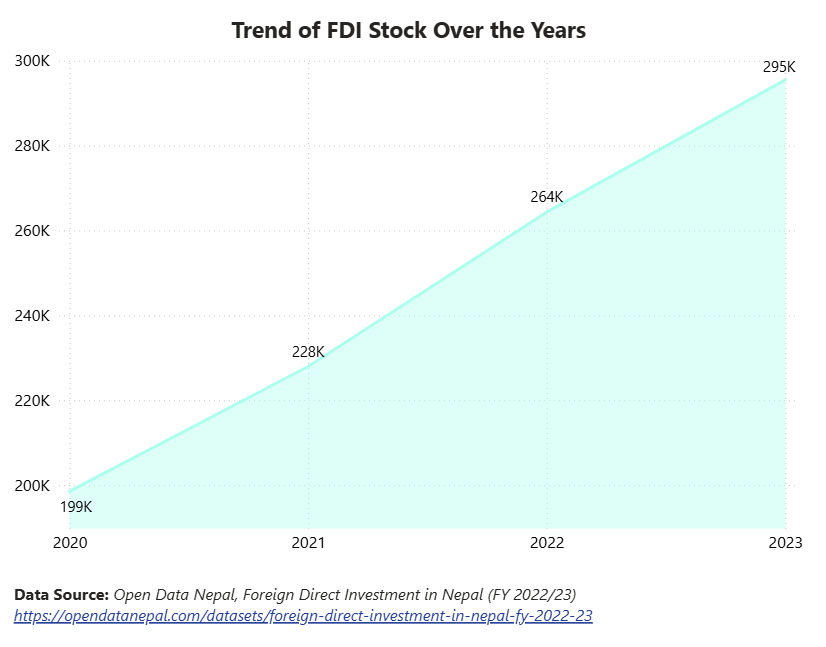
However, the history of FDI is very long, the official records can be found from the 1980s. Nepal started policy reforms at this time which created a favorable environment for FDI. In the initial period the volume was minimal, which averages Rs. 45 million annually during 1980–1989. It increased to Rs. 18 billion annually in 1990. But the increasing trend did not sustain for a long time. The flow of FDI declined after the mid-1990s due to political instability and security concerns, and slow policy reforms. However, the initiation of the government in attracting more FDI, the capital inflows increased gradually in the latter period.
Between 2020 and 2023, Nepal’s FDI stock climbed steadily, reaching Rs. 295.5 billion in 2023, the highest till date. Despite global economic instability and turbulence, Nepal managed to hold its ground when we look at this data. Much of this stability came from ongoing projects, particularly in energy and manufacturing. Still, the picture isn’t perfectly balanced. Some sectors are thriving, while others remain on the sidelines.
Who’s Investing? The Global Picture
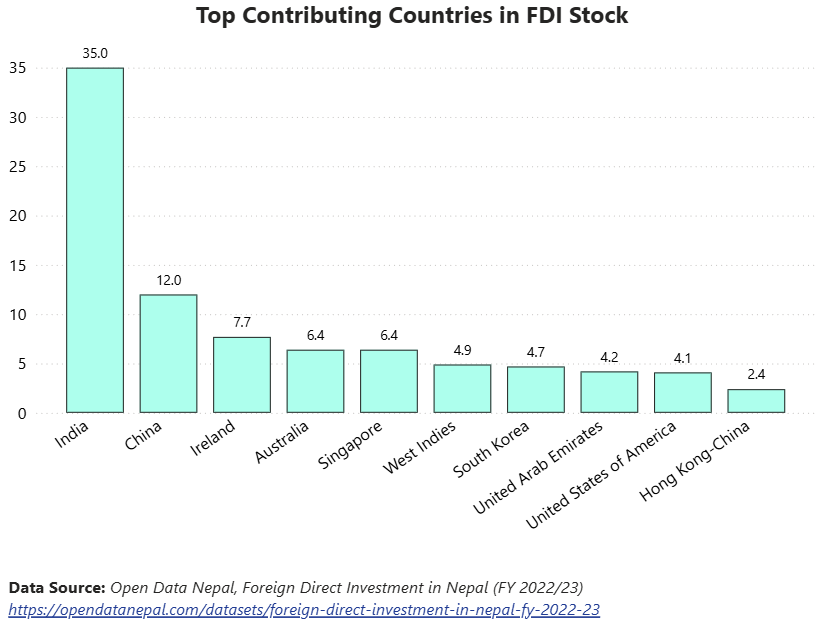
Nepal has received FDI from about five dozen countries of the world. The number was 58 in the year 2023. Nepal’s two economically giant countries ;India and China fall top on the list. India ranks top followed by China. The Ireland and Australia come after.
Beyond them, a handful of Asian and European nations contribute smaller portions. India’s lead is no surprise since Nepal shares deep economic and cultural ties with the additional fact of open borders and easily mobility between the countries. Meanwhile, China’s expanding involvement, especially in hydropower and large infrastructure projects, has become increasingly visible. It’s a mixed situation: valuable to have such strong partners, yet potentially risky when two countries hold most of the influence in Nepal’s investment landscape.
Where It Flows: The Geography of Investment
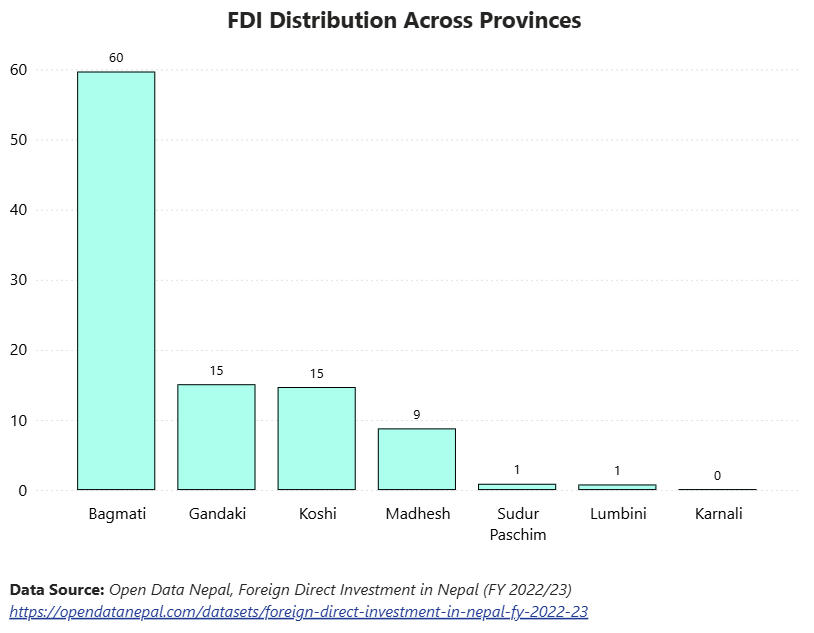
While we look upon the geographical distribution of FDI in Nepal, the picture is not satisfactory. The FDI in Nepal is highly concentrated in specific regions, with the Kathmandu Valley being the primary destination. More than one-third of all FDI projects are in the Kathmandu Valley. This has made the Bagmati province at the top of the list. The Bagmati provinces hold approximately two-third of the total FDI. Gandaki, Koshi, Lumbini, Karnali, and Sudur Paschim provinces follow. Sudur Paschim and Lumbini province have a share of one percent each. Karnali, the remote area shares almost nil FDI.
This vast difference in the regional concentration of FDI in Nepal is due to many factors. The population distribution, physical infrastructures, market size and most importantly, the remoteness of the administrative center. This is the reason that FDI is concentrated in Kathmandu valley, the capital city, and the Bagmati province. In ecological regions, Terai has more share of FDIs compared to Hill and Mountain regions. Terai region is very close to India, the top FDI contributor in Nepal. This uneven distribution highlights a significant challenge in achieving more balanced regional development through FDI.
Where Does the Money Go? The Sectors Driving Growth
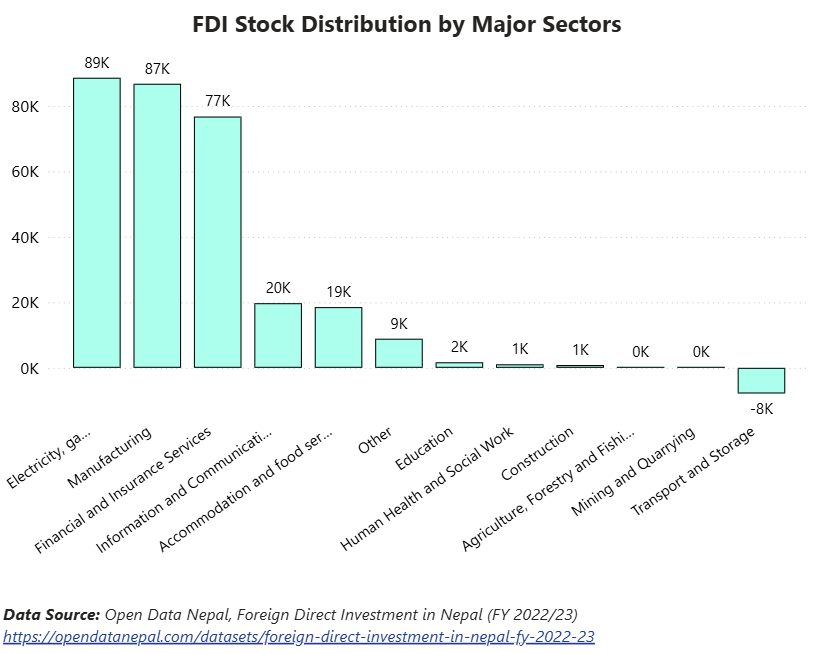
When we look upon the sectors of FDI in Nepal hydropower is on the top, which accounts for approximately 40-45% of inflows. It shows the huge potential of hydro-electricity potential of the country. The hydropower sector is followed by telecommunications and manufacturing. After that come Manufacturing, Tourism, and Construction.
The Transport and Storage sector didn’t just fail to attract new FDI it actually lost foreign investment over those years, resulting in a negative balance. However, this concentration of investment also creates structural risks. If the energy sector slows down, the effects could ripple across the broader economy.
The electricity, gas, steam, and air conditioning sector accounts for about one-third of total FDI stock, followed by the manufacturing sector. The industrial sector which includes these two sectors accounts for more than half of the total FDI stock. The service sector attracts about 40 percent of total FDI stock.
And yet, a quiet question remains: are these figures proof of balanced, sustainable growth, or do they simply look good on paper?
Nepal’s annual FDI inflows is less than 0.5 percent of its GDP in recent years. This is modest, but significantly lower than regional peers. This limited impact is attributed to persistent challenges including political instability, inadequate infrastructure, complex bureaucracy, and difficulties in land acquisition. It demands more reforms in policy and infrastructure development. Nepal has a lot to do in improving the investment climate.
Comparing the Giants: India and China by Sector
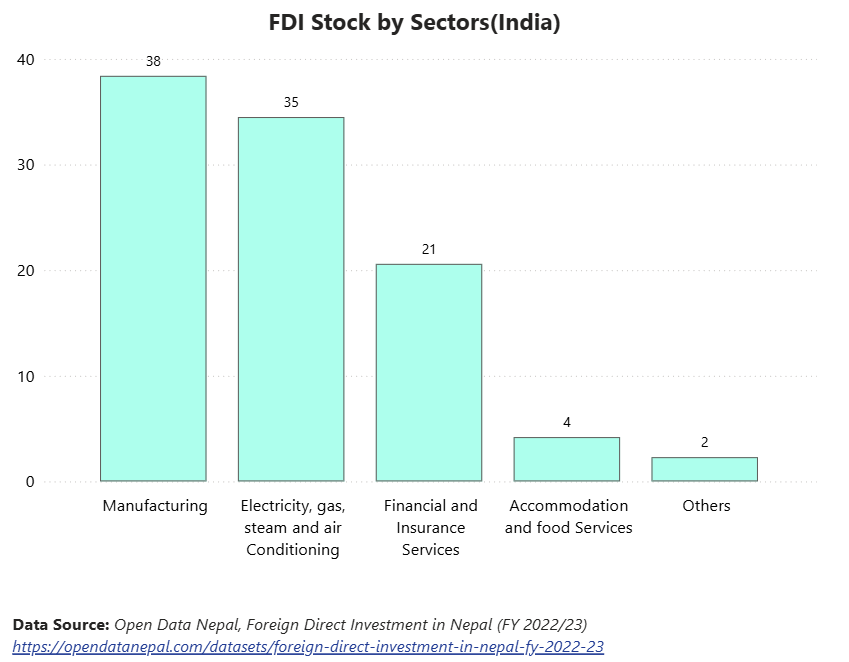
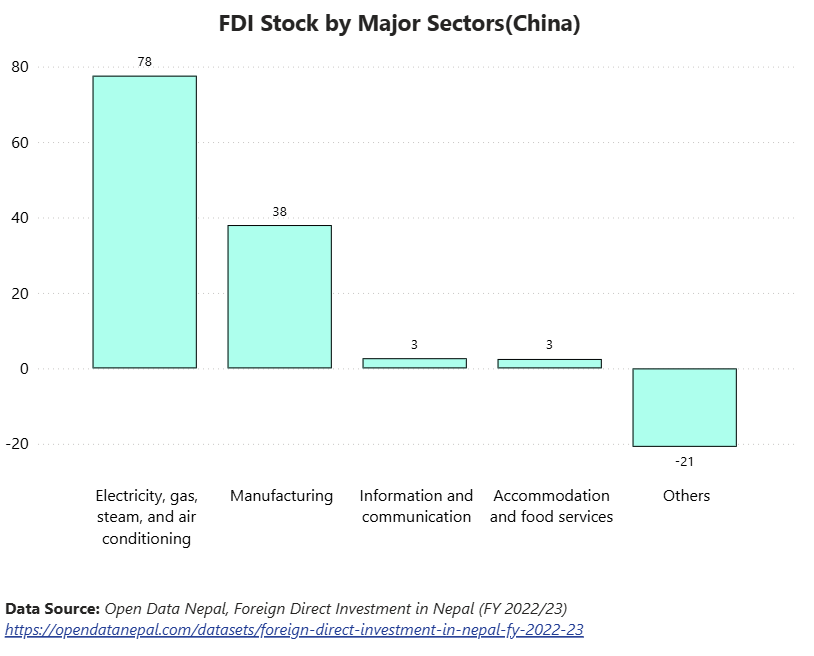
When you look closely, you can really see how differently India and China invest in Nepal. India puts its money into manufacturing, construction, and finance sectors that help build industries and strengthen trade networks. China, on the other hand, focuses mostly on energy projects, especially hydropower. It’s almost like two different playbooks for development: one driven by industry and commerce, the other by power and infrastructure. Together, these two countries make up nearly two-thirds of Nepal’s total foreign investment.
Nepal’s FDI story has many layers. On the surface, it reflects consistent, encouraging, and globally connected growth. But beneath that, patterns of concentration and dependency begin to show. For long-term sustainability, Nepal needs diversification across sectors, regions, and partners. The next step should be broadening investment sources, expanding opportunities beyond Bagmati, and encouraging reinvestment of profits within the domestic economy.
About this analysis
This analysis is based on data from the Nepal Rastra Bank (NRB) and aggregated datasets on Foreign Direct Investment available through Open Data Nepal (ODN). The primary source of information is the Foreign Direct Investment in Nepal Report, FY 2022/23, published by the NRB.

